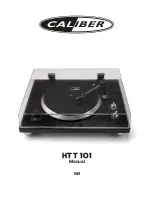
6
Move the cartridge so that the stylus rests on the dot. Now, viewing the cartridge from
above, line it up so that its sides are symmetrically positioned between the lines of the
grid. If the cartridge has parallel sides, these should be made parallel to the grid lines.
Also make sure that the cartridge is centered between the sets of lines.
Double check the adjustments made above. The cartridge needs to be both centered
and "square" between the gird lines and have the stylus resting on the dot.
The alignment gauge does not have a hole or dimple to hold the stylus. While the
printed dot makes it harder to keep the stylus in place, this method was chosen to avoid
the possibility of damaging the stylus cantilever or the diamond tip as the cartridge is
positioned.
Place the arm back in its rest and without letting the cartridge move, tighten the screws
holding cartridge to the headshell. Make it tight, but don't over do it and strip the
threads or distort the cartridge body.
Double check the horizontal balance, lateral balance, and tracking force and adjust as
needed. Increase the tracking force by 1/10 of a gram above the cartridge
manufacturers highest recommended force. See Sections D and F above.
ARM HEIGHT:
Unlike many tone arms, the JMW's height is both easy and repeatable to vary. The
knob next to the bearing housing bears a scale numbered from zero to ninety-nine.
Below the knob there is an index mark engraved on the front of the support pillar.
Rotating the knob clockwise lowers the arm and rotating it counterclockwise raises it.
Set the arm height as follows:
Start the turntable and place a record on it. Lower the arm onto the record and make
the arm tube parallel to the record surface by rotating the arm-height knob as needed.
This is a good initial setting. You may wish to vary it depending on the cartridge you
are using and or the particular record being played. The knob's scale makes it easy to
return to a previous setting by making a note of the number above the index mark and
the number of complete turns taken.
If you have a gentle touch (so as not to bounce the turntable) you can simply vary the
arm height while listening to the record and the changes in distortion that results.
Depending upon your patience and other mental factors, you could go through this
process for every record you own. Or, as most of us do, you can find a setting that
works for most records and sit back and listen to the music.
On the platter side of the adjustment knob's housing is a thumbscrew. When finished
with adjustments tighten this thumbscrew as much as possible by hand.
AllegroSound.com
Summary of Contents for JMW 10
Page 9: ......



























